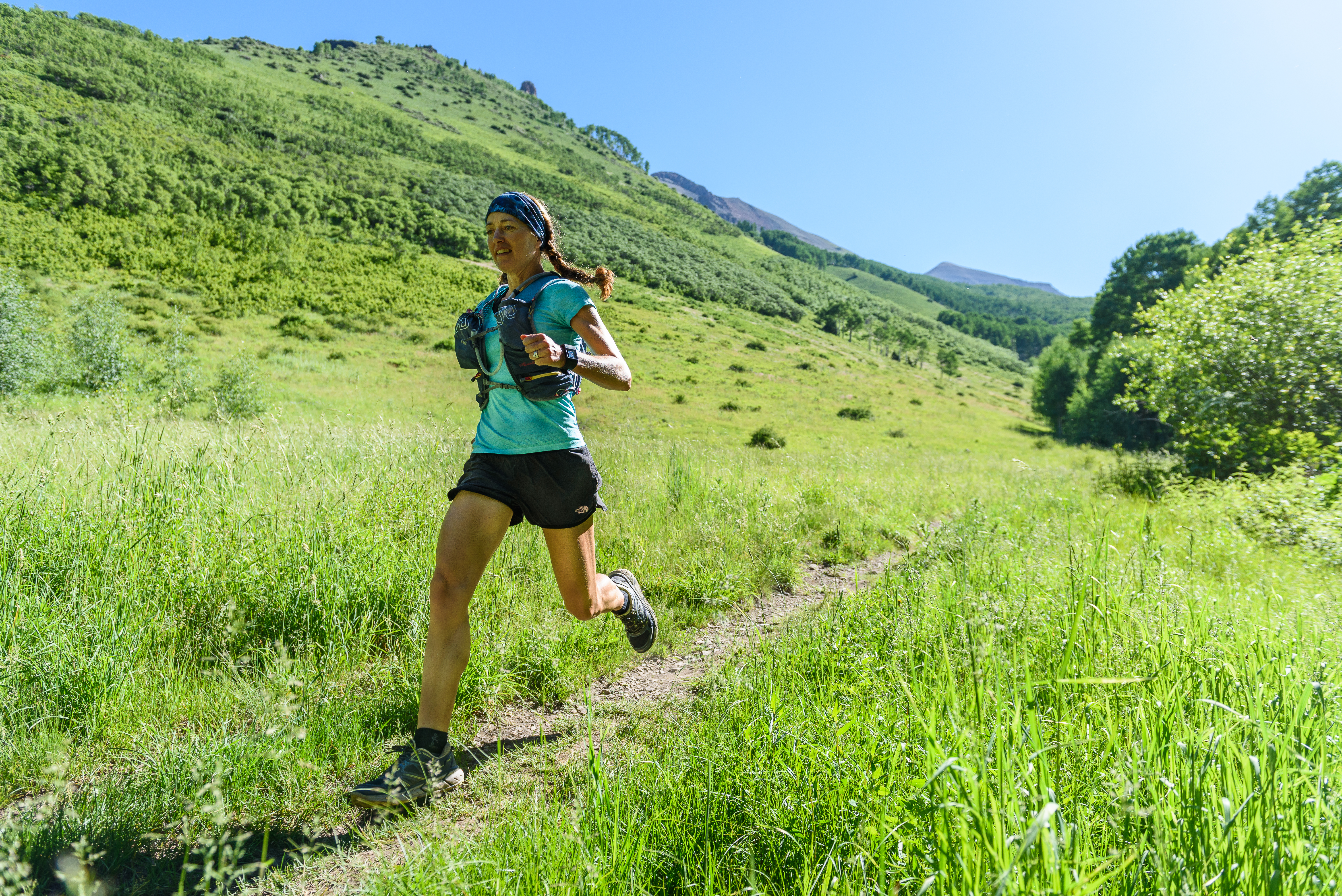
Running a smooth stretch of trail near our property on Deep Creek Mesa outside of Telluride. Photo by Howie Stern
Running through an aspen grove on the Mill Creek Waterline Trail above Telluride, two-thirds of the way through the roughly 37-mile August 6 Telluride Mountain Run, I rejoiced in the relative ease of this mostly flat, momentarily buffed-out trail—a rarity around here.
A steady rain soaked through my layers, but I didn’t mind because I didn’t hear thunder. The typical monsoon-season afternoon lightning decided to take a day off and spare me, so the rain felt like a mere nuisance. The day prior, I was so scared about the forecast for an electrical storm that I practiced the lightning pose in our Airstream.

Practicing the lightning pose in our Airstream during a storm. The idea is to minimize your contact with the ground.
(Lightning here in the San Juan Mountain range is no joke. Morgan made that GIF above from a series of shots taken from our property.)
At this point in the race, I put my trekking poles away for the stretch, and then I ran, legit, for more than 10 minutes, no hiking breaks. For the first time all day (not including when I sped up on the long descents), my pace got down to around 11 minutes per mile. On a course with some 14,000 feet of climbing, a sub-12-minute mile felt more like a flying 5K race pace than granny gear.
According to my GPS, I hit the 26-mile mark in 7 hours, 10 minutes. Imagine that: This marathon distance took double the time—plus one hour!—longer than my marathon PR of 3:05.
I could get down on myself for running so slowly, but I let go of my Bay Area notions of trail-running time. In spite of taking more than 7 hours to do a marathon, I actually was doing well compared to others. I went on to finish 6th female in 9:45 (and the top 5 were all under 40, whereas I’m a dinosaur at 47), and overall I finished in the top half of a field dominated by younger, skinnier, altitude-adapted mountain-running dudes.
Here’s a photo from the event’s twitter feed that gives a glimpse at just a fraction of its rugged route:
Tomorrow, you will go from there to here. #telluridemountainrun @salomonrunning @ClifBar @drymaxsocks pic.twitter.com/xDvaTnN1R9
— TellurideMountainRun (@RunTelluride) August 5, 2016
This type of mountain running deserves its own category, between road running and trail running. You could call it “extreme fast trekking.” It’s hard to articulate how ridiculously slow and tough it is, but I’ll try.
I came to Telluride, Colorado, after a season of getting in the best shape I could for the 100-mile Western States Endurance Run (see race report), so it’s fair to say I was in good shape and well-adapted for ultra-distance trail running this summer.
No matter. One again, the San Juan Mountains put me in my place and made me feel weak, slow, awestruck and sometimes scared.
My first test of mountain fitness and agility this summer came on July 23, when I raced the 12-mile Kendall Mountain Run in Silverton. It’s a U.S. Skyrunning event that goes straight up six miles to a summit scramble, then straight down. I gasped for breath and struggled with the climb to the summit, but I got up and down as efficiently as possible, shaving 13 minutes off my time from the prior year (finishing merely midpack, but not bad given the A-level competition).
I love this photo from Myke Hermsmeyer of Kendall Mountain Run champion Emelie Forsberg catapulting to the top, using her hands, because it shows “running” as full-body, ass-hauling movement on gnarly terrain:
A photo posted by Myke Hermsmeyer (@mykehphoto) on
Over the past two months, while living at 9000 feet and frequently hiking and climbing to ridges around 13,000, I developed legs and lungs better suited for running in this region—but I’m still humbled by each so-called run.
For any sea-level trail runner who plans to run in the Rockies or other high-altitude mountainous regions, I offer the following seven tips:
1. Check your ego at the trailhead. Feeling slower, older, clumsier, hungrier, colder and wheezier while running in this environment goes with the territory. You could feel frustrated with yourself, or you could accept it and do the best you can while celebrating and soaking up the scenery. Don’t feel guilty about your weekly mileage volume dropping. Focus on the time on your feet and the difficulty of terrain, not the number of miles. My experience is that a 35-mile week in the Colorado mountains feels harder and takes roughly the same amount of time as a 50-mile week on Northern California trails. Here in Colorado, I average maybe 4 mph (15 min/mile pace) on trails and rocky dirt roads, so 35 miles equates to nearly 9 hours of running; in regular trail and road running around my Bay Area home, a 50-mile week totals around 9 hours, too.
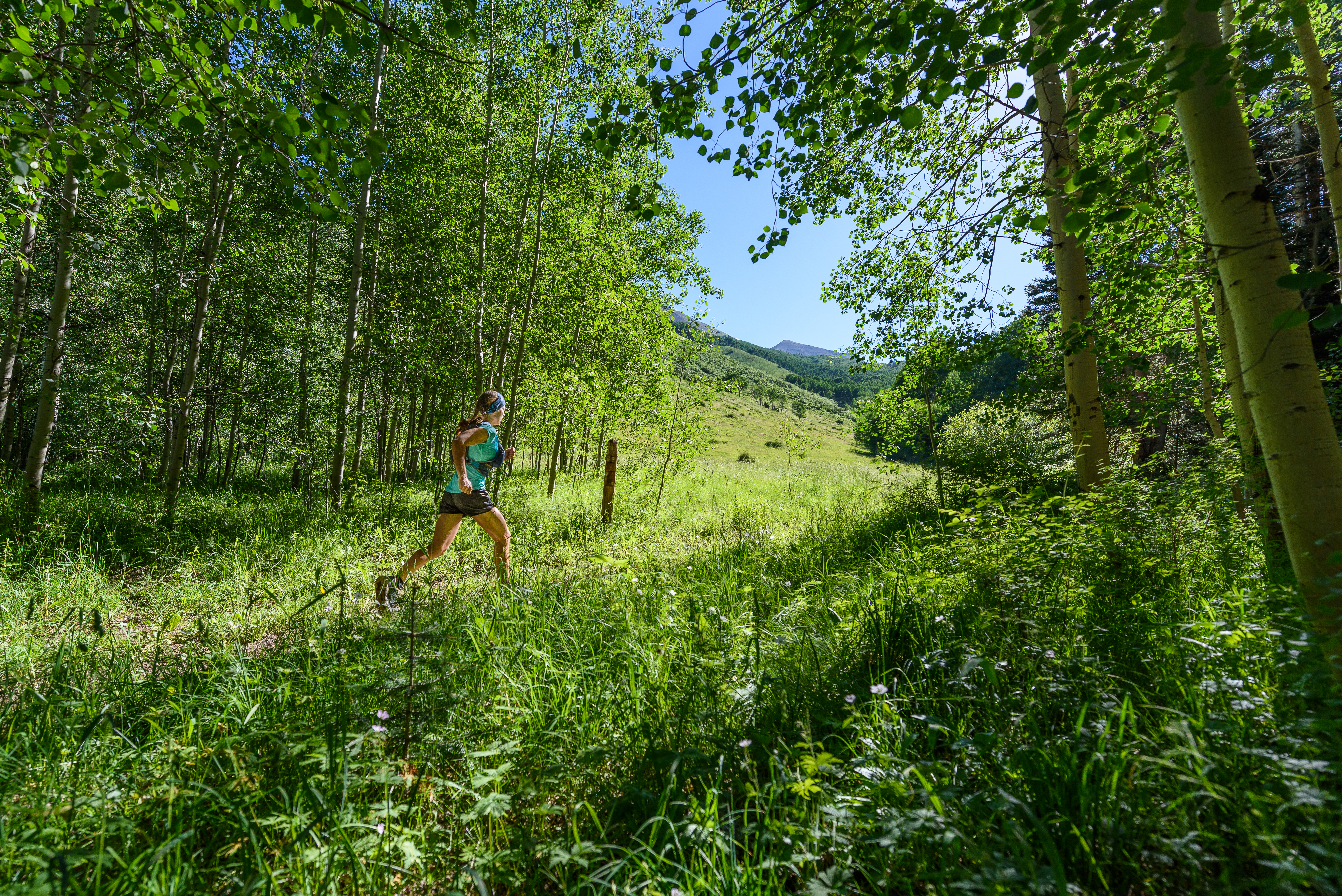
Heading up the Deep Creek Trail behind our property, slowly and breathing hard. Photo by Howie Stern
2. Expand your definition of “running.” Again and again, while “running” around these mountains, I was reminded of a lesson former Western States 100 champ Geoff Roes gave me and others when we attended his Alaska Ultrarunning Camp in Juneau back in 2012. Running is not necessarily defined by the gait in which both feet are never on the ground at the same time; running does not have to mean always moving at a speed of, say, 5 to 10 miles per hour (a 12 to 6 minute/mile pace). Rather, running is about moving as efficiently and quickly over land, on foot, as you can. Oftentimes, “running” up the mountain actually is a form of hiking that integrates scrambling, sliding and clutching, as during the Telluride Mountain Run when the course sent us up a trail-less avalanche slide of loose rock and dense vegetation, which included lots of face-slapping and calf-scratching willow and aspen branches.
3. Take more calories than you think you need. Your body will burn calories like a furnace in this mountain air because of an elevated heart rate and, frequently, a cold wind or rain that makes your body work harder to generate adequate heat. Also, you should factor in the likelihood that the whole outing might take longer than you planned. Starting after the first hour of the Telluride Mountain Run, I ate roughly 200 calories per hour (VFuel gels and Clif bloks, mostly), but then I’d also eat a bar at the aid stations. I noticed that I wanted to wolf down the whole 200-calorie bar at once, and it felt good in my stomach and great for my energy level, whereas in ultras I typically nibble a bar, one small bite at a time, making it last over an hour to avoid upset stomach.
Mountain running makes me eat on the run like a goat: always chewing, eating and digesting anything.
4. Take more fluids than you think you need. The dry mountain air, combined with increased respiration, means you can drain a bottle in a mere half hour. Don’t be fooled into thinking you aren’t sweating much, so you don’t need so much hydration. You probably are sweating a lot, but the sweat immediately evaporates in this climate so you might not notice the loss of fluid and electrolytes.
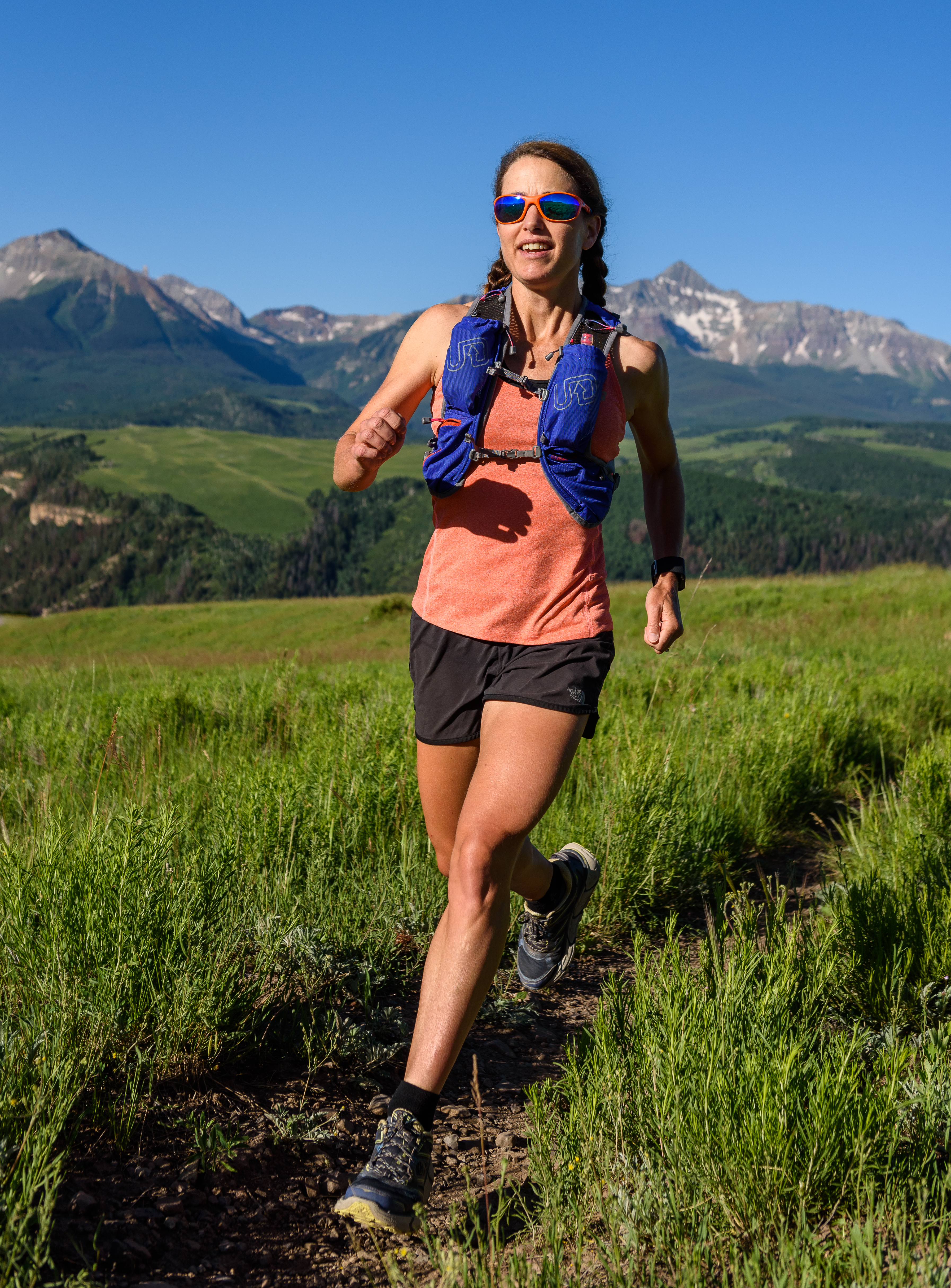
I always take a hydration vest on trail runs in Colorado, even on relatively easy short ones like this, with Mt. Wilson and Sunshine in the background. Photo by Howie Stern
5. Take more clothing layers and safety gear than you think you need. The weather changes hourly, quickly turning severe. Cell phones often don’t work. Even for a relatively easy run on a familiar trail, I take a windbreaker, gloves and a signaling device; for anything longer than an hour on a backcountry trail, I’ll throw my handy-dandy first aid kit in my pack. I took a two-day NOLS WMI Wilderness First Aid course earlier this month, learned a ton, and I highly recommend that anyone serious about spending time in the backcountry take a similar course.
6. On “easy” days, let yourself hike more and catch your breath. I abide by the adage for training, “make your easy days easy, and your hard days hard.” Most of your training should be easy and manageable, meaning you should feel relaxed and be able to carry on a conversation. (A Trail Runner magazine writer/coach/runner colleague whom I admire, David Roche, recently wrote this article about the importance of running most—but not all—of your weekly mileage at a slow and easy pace.) At a mountain altitude and terrain like this, however, almost any running makes your heart rate spike and makes you breathe past the point of being able to speak in complete sentences. Therefore, on deliberately easy days, you need to give yourself license to hike all the uphills and only run flats and descents.
7. Trekking poles are your friend. On some of the most steep, scree-covered mountainsides, trekking poles can be a lifesaver. On the way up, I use them to transfer some of the work to my upper body; on sharp descents, they save my knees and prevent falling. When I bombed down the ski runs in the final mile of the Telluride Mountain Run, I loved getting into a rhythm of planting my poles as if downhill skiing, and transferring some of the impact to them so my legs didn’t take 100 percent of the pounding.

This is a training run up Marshall Basin, above Tomboy Road, on the way to the 13,000-foot Mendota Saddle. This is part of the Telluride Mountain Run, but on race day, a dark gray cloud with rain shrouded the ridge. (Photo by Yitka Winn)
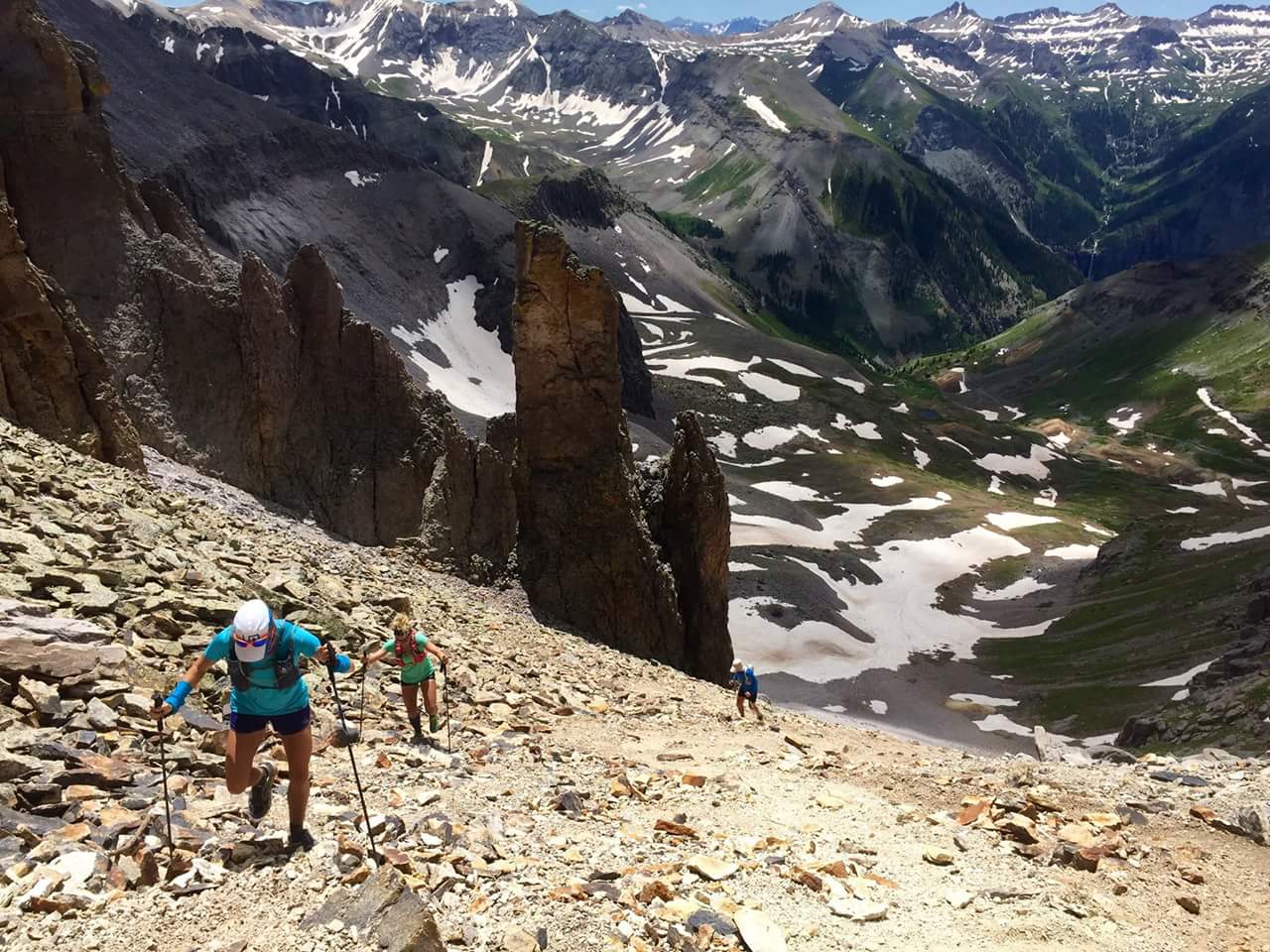
That’s me in front, ascending Virginius Pass on a Hardrock 100 training run in early July with Katie DeSplinter Grossman and Scott Mills (photo by Meghan Hicks, courtesy Scott’s FB page). The trekking poles become even more helpful on the way down on a scree and talus field like that!
I’ve had my trusty ultra-light, collapsible Black Diamond Z Polesfor five years and love them! They are not size adjustable, so get the correct size for your height. (I’m 5’7″ and use 110cm.) I also love how they fit in my Ultimate Direction Adventure Vesta‘s trekking pole loop holders on each side of my chest. The Adventure Vesta works really well for mountain running, given its larger capacity for carrying extra layers, an optional hydration reservoir in addition to bottles in shoulder holsters, and roomy pockets.

This pic of me with my friend Yitka Winn, at the Telluride Mountain Run start, shows my folded-up trekking pole held through the two loops on the side of the UD Adventure Vesta.
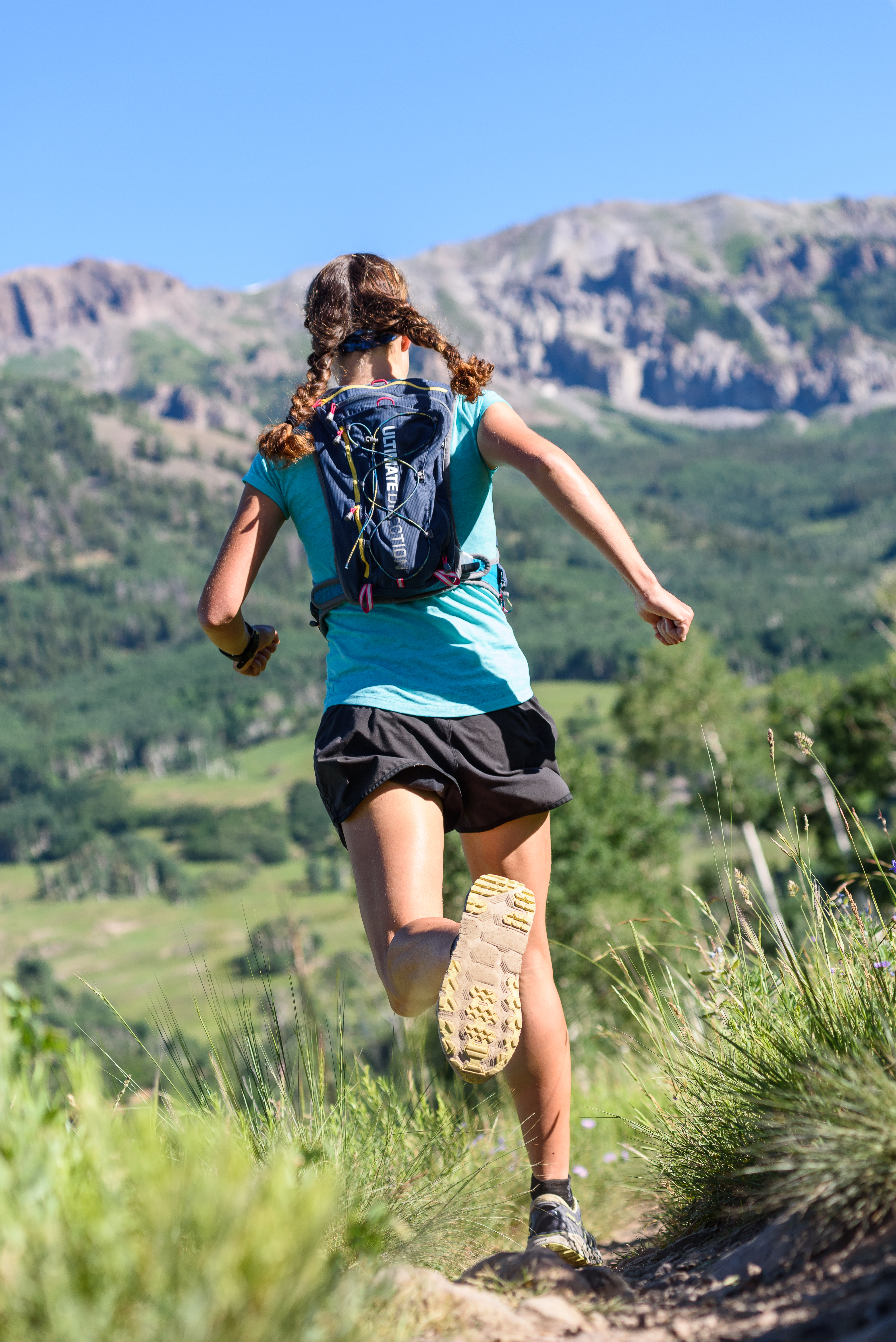
This backside view shows my Ultimate Direction Adventure Vesta (and the sole of my Hoka Challenger ATR shoe). Photo by Howie Stern
A personal note: Sadly, summer is wrapping up. I treasured this summer; this post has been about running, but really, these past couple of months marked a milestone for our family, as we made a new home that reconnected with family roots, and we experienced living as a foursome in the small space of an Airstream and canvas tent annex. Next week we drive to Ojai in Southern California to drop my son off for his sophomore year at The Thacher School; then, we take my daughter to Providence, RI, to start college at the Rhode Island School of Design.
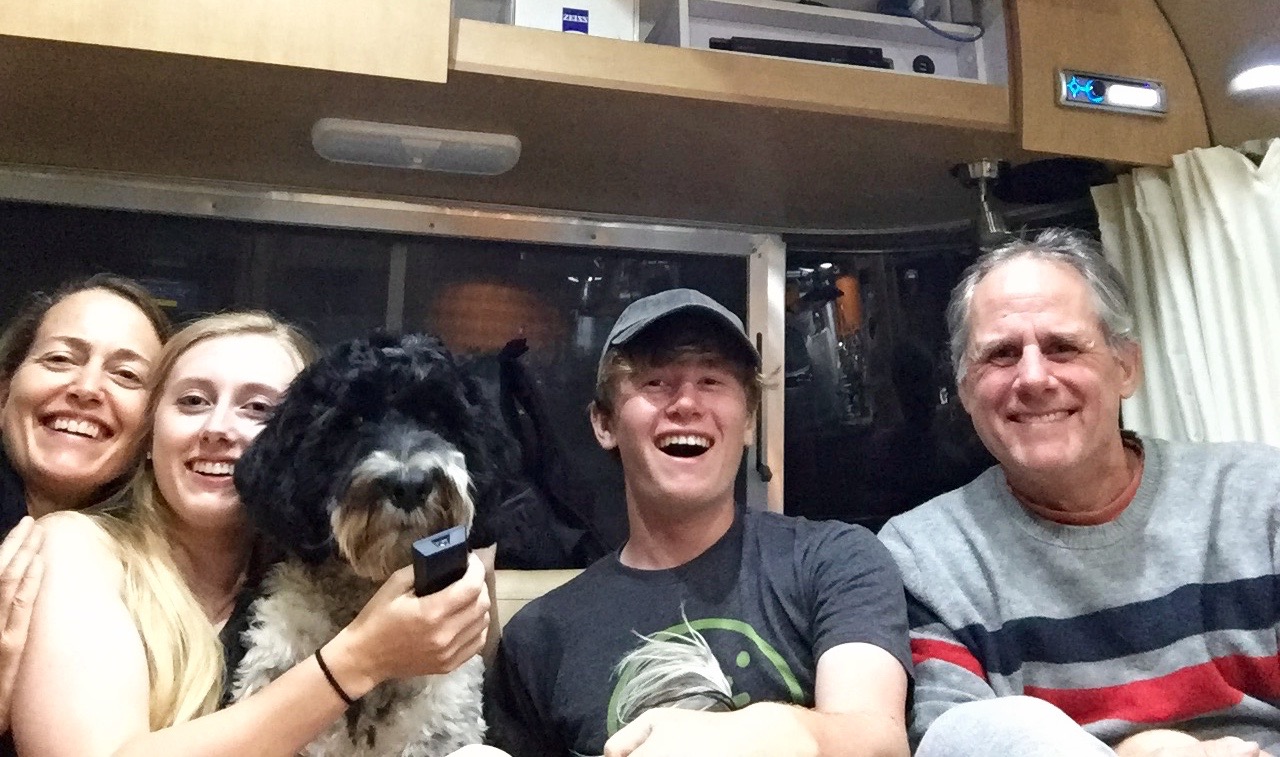
Our family (me, Colly, Beso the dog, Kyle, Morgan) in our Airstream watching TV, trying to get the spotty WiFi to work well enough to stream a show.
When my nest empties, I’ll take solace in the trails.
For Further Reading:
“An Ode to Telluride, Family Ghosts and the Hardrock Spirit”: My archived column about the Hardrock “Wild & Tough” spirit and how childhood summers in Telluride shaped me.
Dakota Jones’ column about the Telluride Mountain Run (he’s the co-RD).
A note about the photographs: Many thanks to Howie Stern for several of the photos above. Howie—a Hardrock 100 veteran and outdoors photographer—took some photos of me for a project I’m working on. Check out Howie’s fantastic portfolio on howiestern.com.


PERFECT TIMING on this article, Sarah! Coming from the Bay, too, my last 50 miler on 7/27 was up in Colorado, the Pike’s Peak area. Although we didn’t summit PP, we summited Mount Rosa at 11,800′.
“I could get down on myself for running so slowly, but I let go of my Bay Area notions of trail-running time.”
You’ve got great advice, run slow, check the ego and eat like crazy for any run at altitude/runs along mountains that don’t have well traveled or well packed trails. Castle Peak 100k in Truckee coming up and although altitude will be lower than Pikes Peak (max 9k), there will be about 1.2 miles of scrambling, sliding and semi-bouldering. I’ll be keeping it slow and steady and enjoying the challenge of whatever terrain is introduced. Thanks for the advice!
You’ll do great at Castle Peak, Erin! I should add, however, that “eat like crazy” can backfire when racing so still be careful to not overdo it when racing, so that your gut doesn’t struggle to digest when your blood flow mainly needs to go to your muscles and skin. (More mellow training runs, with breaks, I find I can & want to eat more.) 250 cals, maybe 300 in long ultras, is the max most people can handle per hour when running, and when you’re pushing yourself in a race environment — even at a slow mountain pace — your heart and breathing rates likely will be elevated to the point where easy-to-digest gels & chews and only nibbles of solids periodically are the best bet. I find for ultras that go past a half day, it’s good to have a steady small amount of cals/hour after the first hour (like 200-250) but then around noon and again in late afternoon/early evening — when I’m accustomed to lunch & dinner — it’s good to have a more substantial snack of real food. Let’s get together in the East Bay in Sept for a run/hike when you’re recovering from Castle Peak so I can hear about it. Good luck!
Hey hey Sarah,
Hope all is well with you.
Really enjoyed the post, and great to get your thoughts on altitude running.
Catchya later!😃
I live and run at sea level, but have mountain dreams; this article was both practical and inspiring. Thanks!